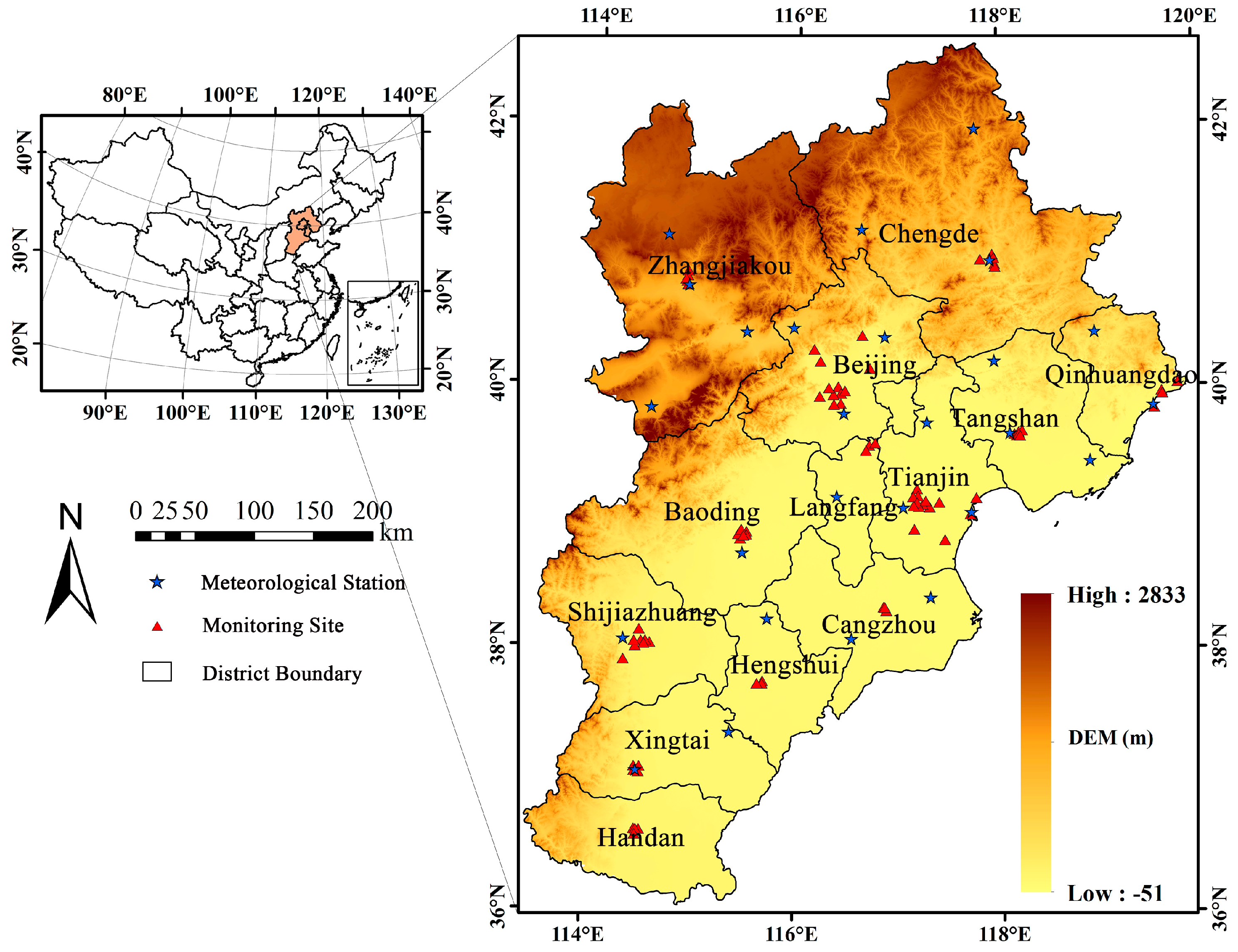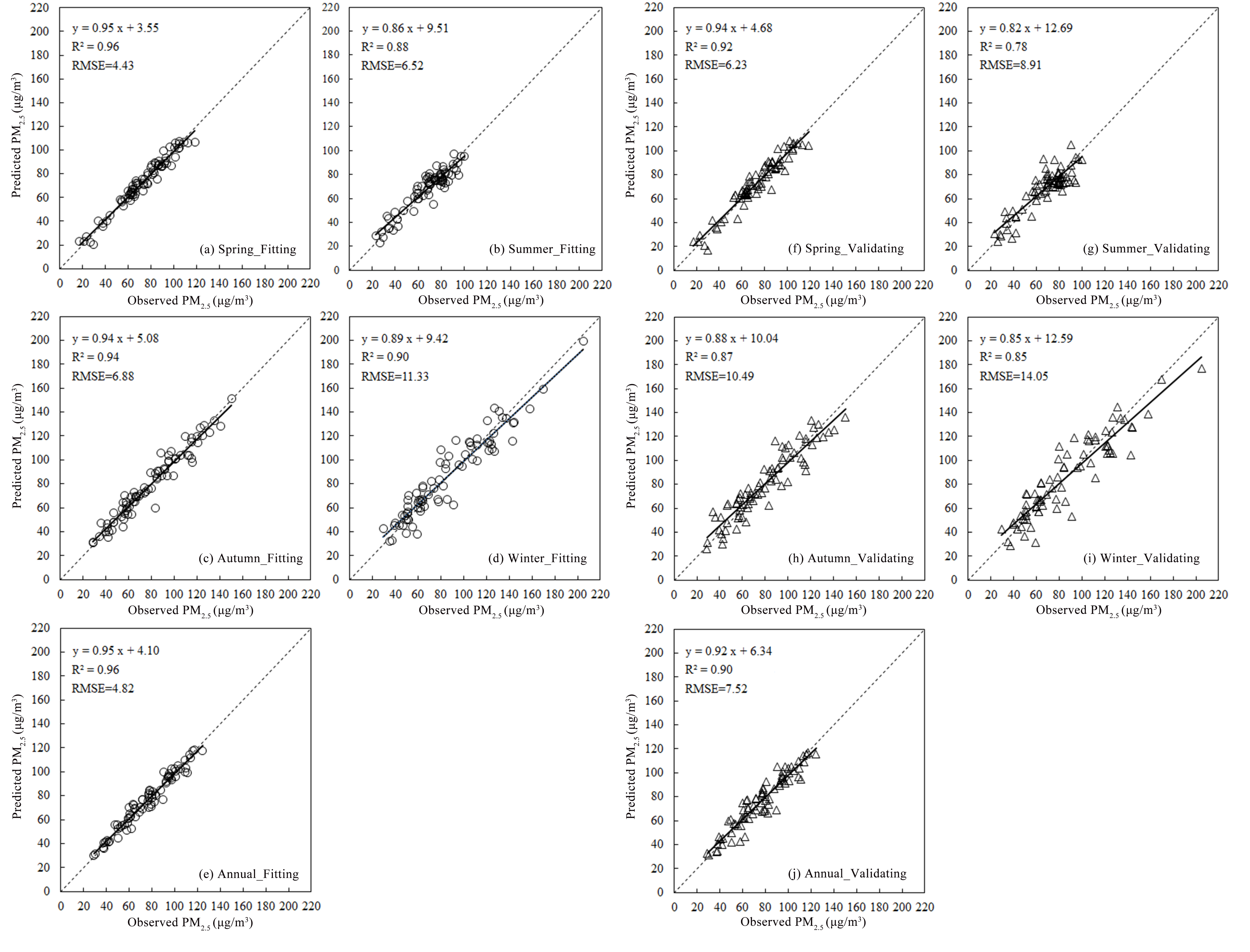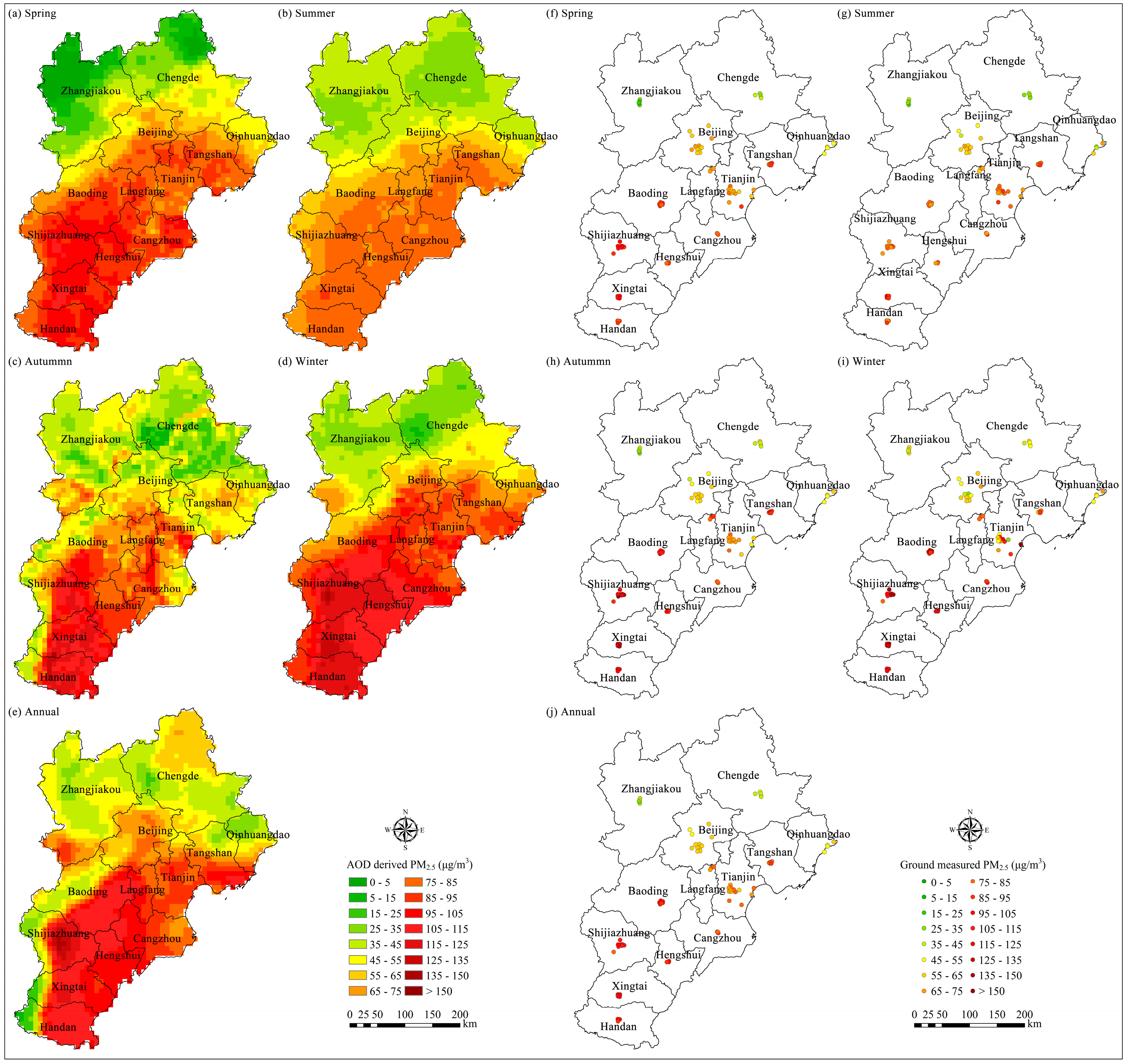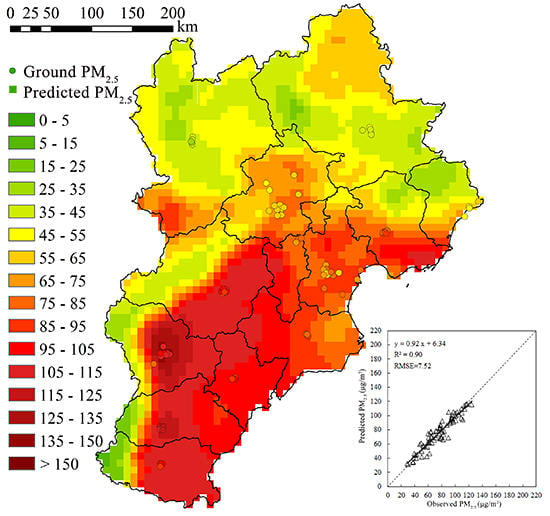Satellite Based Mapping of Ground PM2.5 Concentration Using Generalized Additive Modeling
Abstract
:1. Introduction
2. Data and Methods
2.1. Study Area
2.2. Data Collection and Preprocessing
2.2.1. In Situ PM2.5 Data
2.2.2. Satellite-Retrieved AOD Data
2.2.3. PM2.5 Emissions Related Data
2.2.4. Dispersion Conditions Data
2.2.5. Data Integration
2.3. GAM Modeling
2.3.1. GAM Structure
2.3.2. Thin Plate Regression Splines
2.3.3. Model Development and Validation
3. Results
3.1. Model Fitting and Validation
3.2. Contributing Factors of GAM Models
3.3. PM2.5 Concentration Surfacesacross Time Scales
4. Discussion
5. Conclusions
Acknowledgments
Author Contributions
Conflicts of Interest
Abbreviations
| BTH | Beijing-Tianjin-Hebei region |
| GAM | Generalized Additive Model |
| RMSE | Root Mean Square Error |
| LUR | land Use Regression |
| AOD | Aerosol Optical Depth |
| CTM | Chemical Transport Model |
| GIS | Geographic Information Systems |
| NCP | North China Plain |
| CEMC | China Environmental Monitoring Center |
| TEOM | Tapered Element Oscillating Microbalance |
| CNAAQS | Chinese National Ambient Air Quality Standards |
| GTS | Global Telecommunication System |
| CNMC | Chinese National Meteorological Information Center |
| RESDC | Data Center for Resources and Environmental Sciences |
| NASA | National Aeronautics and Space Administration |
| USGS | United States Geological Survey |
| GLM | Generalized Linear Model |
| AIC | Akaike Information Criterion |
| CV | Cross Validation |
| WHO IT-1 | World Health Organization Air Quality Interim Target II-1 |
References
- Pope, C.A., III; Dockery, D.W. Health effects of fine particulate air pollution: Lines that connect. J. Air Waste Manag. 2006, 56, 709–742. [Google Scholar] [CrossRef]
- Sacks, J.D.; Stanek, L.W.; Luben, T.J.; Johns, D.O.; Buckley, B.J.; Brown, J.S.; Ross, M. Particulate matter-induced health effects: Who is susceptible? Environ. Health Perspect. 2011, 119, 446–454. [Google Scholar] [CrossRef] [PubMed]
- Crouse, D.L.; Peters, P.A.; van Donkelaar, A.; Goldberg, M.S.; Villeneuve, P.J.; Brion, O.; Khan, S.; Atari, D.O.; Jerrett, M.; Pope, C.A., III; et al. Risk of nonaccidental and cardiovascular mortality in relation to long-term exposure to low concentrations of fine particulate matter: A Canadian national-level cohort study. Environ. Health Perspect. 2012, 120, 708. [Google Scholar] [CrossRef] [PubMed]
- Zou, B.; Wilson, J.G.; Zhan, F.B.; Zeng, Y. Air pollution exposure assessment methods utilized in epidemiological studies. J. Environ. Monit. 2009, 11, 475–490. [Google Scholar] [CrossRef] [PubMed]
- Lim, S.S.; Vos, T.; Flaxman, A.D.; Danaei, G.; Shibuya, K.; Adair-Rohani, H.; AlMazroa, M.A.; Amann, M.; Anderson, H.R.; Andrews, K.G.; et al. A comparative risk assessment of burden of disease and injury attributable to 67 risk factors and risk factor clusters in 21 regions, 1990–2010: A systematic analysis for the Global Burden of Disease Study 2010. Lancet 2013, 380, 2224–2260. [Google Scholar] [CrossRef]
- Boys, B.L.; Martin, R.V.; van Donkelaar, A.; MacDonell, R.J.; Hsu, N.C.; Cooper, M.J.; Yantosca, R.M.; Lu, Z.; Streets, D.G.; Zhang, Q.; et al. Fifteen-year global time series of satellite-derived fine particulate matter. Environ. Sci. Technol. 2014, 48, 11109–11118. [Google Scholar] [CrossRef] [PubMed]
- Van Donkelaar, A.; Martin, R.V.; Brauer, M.; Kahn, R.; Levy, R.; Verduzco, C.; Villeneuve, P.J. Global estimates of ambient fine particulate matter concentrations from satellite-based aerosol optical depth: Development and application. Environ. Health Perspect. 2010, 118, 847–855. [Google Scholar] [CrossRef] [PubMed]
- Li, C.; Hsu, N.C.; Tsay, S.C. A study on the potential applications of satellite data in air quality monitoring and forecasting. Atmos. Environ. 2011, 45, 3663–3675. [Google Scholar] [CrossRef]
- Zou, B.; Pu, Q.; Bilal, M.; Weng, Q.; Zhai, L.; Nichol, J.E. High-resolution satellite mapping of fine particulates based on geographically weighted regression. IEEE Trans. Geosci. Remote Sens. 2016, 13, 495–499. [Google Scholar] [CrossRef]
- Song, W.; Jia, H.; Huang, J.; Zhang, Y. A satellite-based geographically weighted regression model for regional PM2.5 estimation over the Pearl River Delta region in China. Remote Sens. Environ. 2014, 154, 1–7. [Google Scholar] [CrossRef]
- Liu, Y.; Paciorek, C.J.; Koutrakis, P. Estimating regional spatial and temporal variability of PM2.5 concentrations using satellite data, meteorology, and land use information. Environ. Health Perspect. 2009, 117, 886–892. [Google Scholar] [CrossRef] [PubMed] [Green Version]
- Ma, Z.; Hu, X.; Huang, L.; Bi, J.; Liu, Y. Estimating ground-level PM2.5 in China using satellite remote sensing. Environ. Sci. Technol. 2014, 48, 7436–7444. [Google Scholar] [CrossRef] [PubMed]
- Zou, B.; Zhan, F.B.; Wilson, J.G.; Zeng, Y. Performance of AERMOD at different time scales. Simul. Model. Pract. Theory 2010, 18, 612–623. [Google Scholar] [CrossRef]
- Jowett, I.G.; Parkyn, S.M.; Richardson, J. Habitat characteristics of crayfish (Paranephrops planifrons) in New Zealand streams using generalised additive models (GAMs). Hydrobiologia 2008, 596, 353–365. [Google Scholar] [CrossRef]
- Leathwick, J.R.; Elith, J.; Hastie, T. Comparative performance of generalized additive models and multivariate adaptive regression splines for statistical modelling of species distributions. Ecol. Model. 2006, 199, 188–196. [Google Scholar] [CrossRef]
- Chen, C.C.; Wu, C.F.; Yu, H.L.; Chan, C.-C.; Cheng, T.S. Spatiotemporal modeling with temporal-invariant variogram subgroups to estimate fine particulate matter PM2.5 concentrations. Atmos. Environ. 2012, 54, 1–8. [Google Scholar] [CrossRef]
- Li, L.; Wu, J.; Ghosh, J.K.; Ritz, B. Estimating spatiotemporal variability of ambient air pollutant concentrations with a hierarchical model. Atmos. Environ. 2013, 71, 54–63. [Google Scholar] [CrossRef] [PubMed]
- Ma, Z.W.; Hu, X.F.; Sayer, A.M.; Levy, R.; Zhang, Q.; Xue, Y.G.; Tong, S.L.; Bi, J.; Huang, L.; Liu, Y. Satellite-based spatiotemporal trends in PM2.5 concentrations: China, 2004–2013. Environ. Health Perspect. 2015. [Google Scholar] [CrossRef] [PubMed]
- Xu, P.; Chen, Y.; Ye, X. Haze, air pollution, and health in China. Lancet 2013, 382, 2067. [Google Scholar] [CrossRef]
- Chang, Y. China needs a tighter PM2.5 limit and a change in priorities. Environ. Sci. Technol. 2012, 46, 7069–7070. [Google Scholar] [CrossRef] [PubMed]
- Gao, M.; Guttikunda, S.K.; Carmichael, G.R.; Wang, Y.; Liu, Z.; Stanier, C.O.; Saide, P.E.; Yu, M. Health impacts and economic losses assessment of the 2013 severe haze event in Beijing area. Sci. Total Environ. 2015, 511, 553–561. [Google Scholar] [CrossRef] [PubMed]
- Dan, M.; Zhuang, G.; Li, X.; Tao, H.; Zhuang, Y. The characteristics of carbonaceous species and their sources in PM2.5 in Beijing. Atmos. Environ. 2004, 38, 3443–3452. [Google Scholar] [CrossRef]
- Zheng, M.; Salmon, L.G.; Schauer, J.J.; Zeng, L.; Kiang, C.S.; Zhang, Y.; Cass, G.R. Seasonal trends in PM2.5 source contributions in Beijing, China. Atmos. Environ. 2005, 39, 3967–3976. [Google Scholar] [CrossRef]
- Che, H.; Xia, X.; Zhu, J.; Li, Z.; Dubovik, O.; Holben, B.; Goloub, P.; Chen, H.; Estelles, V.; Cuevas-Agulló, E.; et al. Column aerosol optical properties and aerosol radiative forcing during a serious haze-fog month over North China Plain in 2013 based on ground-based sunphotometer measurements. Atmos. Chem. Phys. 2014, 14, 2125–2138. [Google Scholar] [CrossRef] [Green Version]
- Guo, S.; Hu, M.; Zamora, M.L.; Peng, J.; Shang, D.; Zheng, J.; Du, Z.; Wu, Z.; Shao, M.; Zeng, L.; et al. Elucidating severe urban haze formation in China. Proc. Natl. Acad. Sci. USA 2014, 111, 17373–17378. [Google Scholar] [CrossRef] [PubMed]
- Meng, X.; Chen, L.; Cai, J.; Zou, B.; Wu, C.F.; Fu, Q.; Zhang, Y.; Liu, Y.; Kan, H. A land use regression model for estimating the NO2 concentration in shanghai, China. Environ. Res. 2015, 137, 308–315. [Google Scholar] [CrossRef] [PubMed]
- Fang, X.; Zou, B.; Liu, X.; Sternberg, T.; Zhai, L. Satellite-based ground PM2.5 estimation using timely structure adaptive modeling. Remote Sens. Environ. 2016, 186, 152–163. [Google Scholar] [CrossRef]
- Remer, L.A.; Kaufman, Y.J.; Tanré, D.; Mattoo, S.; Chu, D.A.; Martins, J.V.; Li, R.-R.; Ichoku, C.; Levy, R.C.; Kleidman, R.G.; et al. The MODIS aerosol algorithm, products, and validation. J. Atmos. Sci. 2005, 62, 947–973. [Google Scholar] [CrossRef]
- Levy, R.C.; Remer, L.A.; Mattoo, S.; Vermote, E.F.; Kaufman, Y.J. Second-generation operational algorithm: Retrieval of aerosol properties over land from inversion of Moderate Resolution Imaging Spectroradiometer spectral reflectance. J. Geophys. Res. Atmos. 2007, 112. [Google Scholar] [CrossRef]
- Levy, R.C.; Remer, L.A.; Tanré, D.; Mattoo, S.; Kaufman, Y.J. Algorithm for Remote Sensing of Tropospheric Aerosol over Dark Targets from MODIS: Collections 005 and 051: Revision 2; 2009. Available online: http://modisatmos.gsfc.nasa.gov/_docs/ATBD_MOD04_C005_rev2.pdf (accessed on 9 January 2016).
- Levy, R.C.; Remer, L.A.; Kleidman, R.G.; Mattoo, S.; Ichoku, C.; Kahn, R.; Eck, T.F. Global evaluation of the Collection 5 MODIS dark-target aerosol products over land. Atmos. Chem. Phys. 2010, 10, 10399–10420. [Google Scholar] [CrossRef] [Green Version]
- Lee, H.J.; Liu, Y.; Coull, B.A.; Schwartz, J.; Koutrakis, P. A novel calibration approach of MODIS AOD data to predict PM2.5 concentrations. Atmos. Chem. Phys. 2011, 11, 7991–8002. [Google Scholar] [CrossRef]
- Liu, Y.; Franklin, M.; Kahn, R.; Koutrakis, P. Using aerosol optical thickness to predict ground-level PM2.5 concentrations in the St. Louis area: A comparison between MISR and MODIS. Remote Sens. Environ. 2007, 107, 33–44. [Google Scholar] [CrossRef]
- Tian, J.; Chen, D. A semi-empirical model for predicting hourly ground-level fine particulate matter (PM2.5) concentration in southern Ontario from satellite remote sensing and ground-based meteorological measurements. Remote Sens. Environ. 2010, 114, 221–229. [Google Scholar] [CrossRef]
- Zou, B.; Peng, F.; Wan, N.; Wilson, J.G.; Xiong, Y. Sulfur dioxide exposure and environmental justice: A multi-scale and source-specific perspective. Atmos. Pollut. Res. 2014, 5, 491–499. [Google Scholar] [CrossRef]
- Zou, B.; Luo, Y.; Wan, N.; Zheng, Z.; Sternberg, T.; Liao, Y. Performance comparison of LUR and OK in PM2.5 concentration mapping: A multidimensional perspective. Sci. Rep. 2015, 5, 8698. [Google Scholar] [CrossRef] [PubMed]
- Hastie, T.J.; Tibshirani, R.J. Generalized additive models. Stat. Sci. 1986, 1, 297–310. [Google Scholar] [CrossRef]
- Duchon, J. Splines Minimizing Rotation-Invariant Semi-Norms in Sobolev Spaces. In Constructive Theory of Functions of Several Variables; Springer: Berlin/Heidelberg, Germany, 1977; pp. 85–100. [Google Scholar]
- Wood, S.N. Thin plate regression splines. J. R. Stat. Soc. Ser. B 2003, 65, 95–114. [Google Scholar] [CrossRef]
- Wood, S.N. MGCV: GAMs and generalized ridge regression for R. R News 2001, 1, 20–25. [Google Scholar]
- Chambers, J.M.; Hastie, T.J. Statistical Models in S; CRC Press, Inc.: Boca Raton, FL, USA, 1991. [Google Scholar]
- Rodriguez, J.D.; Perez, A.; Lozano, J.A. Sensitivity analysis of k-fold cross validation in prediction error estimation. IEEE Trans. Pattern Anal. Mach. Intell. 2010, 32, 569–575. [Google Scholar] [CrossRef] [PubMed]
- Chinese National Ambient Air Quality Standards, GB 3095-2012. Available online: http://kjs.mep.gov.cn/hjbhbz/bzwb/dqhjbh/dqhjzlbz/201203/t20120302_224165.htm (accessed on 12 January 2016).
- Meng, X.; Fu, Q.; Ma, Z.; Chen, L.; Zou, B.; Zhang, Y.; Xue, W.; Wang, J.; Wang, D.; Kan, H.; Liu, Y. Estimating ground-level PM10 in a Chinese city by combining satellite data, meteorological information and a land use regression model. Environ. Pollut. 2016, 208, 177–184. [Google Scholar] [CrossRef] [PubMed]




| GIS Dataset | Predictor Variables | Unit | Buffer Size (m) | |
|---|---|---|---|---|
| AOD | AOD | unitless | NA | |
| Meteorological parameters | Temperature | K | NA | |
| Wind speed | m/s | NA | ||
| Relative humidity | % | NA | ||
| Atmospheric pressure | hPa | NA | ||
| Precipitation | mm | NA | ||
| Pollution sources | Percentage of ground dust area in a buffer | Open pit field | % | 500, 1000, 2000, 3000 |
| Stacked substance | % | 500, 1000, 2000, 3000 | ||
| Construction site | % | 500, 1000, 2000, 3000 | ||
| Natural bare surface | % | 500, 1000, 2000, 3000 | ||
| Crush stampede yard | % | 500, 1000, 2000, 3000 | ||
| Else | % | 500, 1000, 2000, 3000 | ||
| Number of industrial plants in a buffer | Iron and steel smelting and rolling processing plants | count | 400, 600, 800, 1000, 2000, 30,000 | |
| Thermal power plants | count | 400, 600, 800, 1000, 2000, 30,000 | ||
| Heat production and supply plants | count | 400, 600, 800, 1000, 2000, 30,000 | ||
| Cement building materials plants | count | 400, 600, 800, 1000, 2000, 30,000 | ||
| Petrochemical plants | count | 400, 600, 800, 1000, 2000, 30,000 | ||
| Non-ferrous metal smelting and processing plants | count | 400, 600, 800, 1000, 2000, 30,000 | ||
| Coal mining plants | count | 400, 600, 800, 1000, 2000, 30,000 | ||
| Paper and paper products plants | count | 400, 600, 800, 1000, 2000, 30,000 | ||
| Pharmaceutical manufacturing plants | count | 400, 600, 800, 1000, 2000, 30,000 | ||
| Distance to the nearest industrial plants | Iron and steel smelting and rolling processing plants | m | NA | |
| Thermal power plants | m | NA | ||
| Heat production and supply plants | m | NA | ||
| Cement building materials plants | m | NA | ||
| Petrochemical plants | m | NA | ||
| Non-ferrous metal smelting and processing plants | m | NA | ||
| Coal mining plants | m | NA | ||
| Paper and paper products plants | m | NA | ||
| Pharmaceutical manufacturing plants | m | NA | ||
| Road network | Length of all roads in a buffer | m | 50, 60, 70, 80, 90, 100, 150, 250, 300, 350, 400, 450, 500, 1000, 1500, 2000, 2500, 3000, 3500, 4000, 4500, 5000 | |
| Land use/cover | Percentage of built-up area in a buffer | % | 500, 1000, 1500, 2000, 2500, 3000, 3500, 4000, 4500, 5000 | |
| Percentage of forests area in a buffer | % | 500, 1000, 1500, 2000, 2500, 3000, 3500, 4000, 4500, 5000 | ||
| Percentage of grasslands area in a buffer | % | 500, 1000, 1500, 2000, 2500, 3000, 3500, 4000, 4500, 5000 | ||
| Percentage of water area in a buffer | % | 500, 1000, 1500, 2000, 2500, 3000, 3500, 4000, 4500, 5000 | ||
| Terrain | DEM elevation | m | NA | |
| Population | Population density | count | NA | |
| GAM Models Established | LUR Models Established | |
|---|---|---|
| Spring (N = 78) | PM2.5 ≈ s(AOD) + s(WS) + s(TEMP) + s(RH) | PM2.5 ≈ AOD + WS + TEMP + RH |
| Summer (N = 78) | PM2.5 ≈ AOD + s(FOR(5000 m)) + s(BUI(5000 m)) + s(TEMP) | PM2.5 ≈ AOD + TEMP + PRE |
| Autumn (N = 78) | PM2.5 ≈ s(AOD) + s(WS) + s(ELEV) + s(GD(3000 m)) | PM2.5 ≈ AOD + PREC + WS + GD(3000 m) |
| Winter (N = 78) | PM2.5 ≈ s(AOD) + s(CS(2000 m)) + s(TEMP) + WS | PM2.5 ≈ AOD + TEMP + WS + CS(2000 m) |
| Annual (N = 78) | PM2.5 ≈ s(AOD) + s(TEMP) + s(GRA(5000 m)) + s(SS(2000 m)) + WS + PRE | PM2.5 ≈ AOD + WS + GD(3000 m) + PM(600 m) |
| Season | Model Fitting | Cross-Validation | ||||||||
|---|---|---|---|---|---|---|---|---|---|---|
| Adj R2 | RMSE (μg/m3) | Adj R2 | RMSE (μg/m3) | |||||||
| GAM | LUR | GAM | LUR | Bias (%) * | GAM | LUR | GAM | LUR | Bias (%) * | |
| Spring (N = 78) | 0.96 | 0.87 | 4.43 | 7.96 | 44.4 | 0.92 | 0.87 | 6.23 | 8.31 | 25.1 |
| Summer (N = 78) | 0.88 | 0.72 | 6.52 | 9.68 | 32.6 | 0.78 | 0.71 | 8.91 | 9.85 | 9.5 |
| Autumn (N = 78) | 0.94 | 0.83 | 6.88 | 11.60 | 40.7 | 0.87 | 0.84 | 10.49 | 12.68 | 17.3 |
| Winter (N = 78) | 0.90 | 0.84 | 11.33 | 12.20 | 7.1 | 0.85 | 0.84 | 14.05 | 15.13 | 7.1 |
| Annual (N = 78) | 0.96 | 0.83 | 4.82 | 9.32 | 48.3 | 0.90 | 0.85 | 7.52 | 9.78 | 23.1 |
© 2016 by the authors; licensee MDPI, Basel, Switzerland. This article is an open access article distributed under the terms and conditions of the Creative Commons Attribution (CC-BY) license (http://creativecommons.org/licenses/by/4.0/).
Share and Cite
Zou, B.; Chen, J.; Zhai, L.; Fang, X.; Zheng, Z. Satellite Based Mapping of Ground PM2.5 Concentration Using Generalized Additive Modeling. Remote Sens. 2017, 9, 1. https://doi.org/10.3390/rs9010001
Zou B, Chen J, Zhai L, Fang X, Zheng Z. Satellite Based Mapping of Ground PM2.5 Concentration Using Generalized Additive Modeling. Remote Sensing. 2017; 9(1):1. https://doi.org/10.3390/rs9010001
Chicago/Turabian StyleZou, Bin, Jingwen Chen, Liang Zhai, Xin Fang, and Zhong Zheng. 2017. "Satellite Based Mapping of Ground PM2.5 Concentration Using Generalized Additive Modeling" Remote Sensing 9, no. 1: 1. https://doi.org/10.3390/rs9010001







